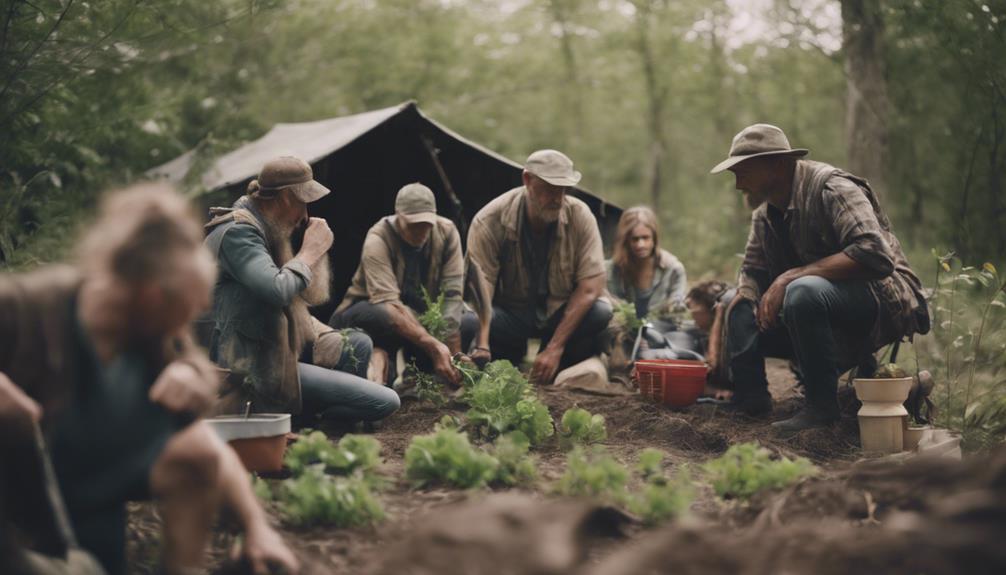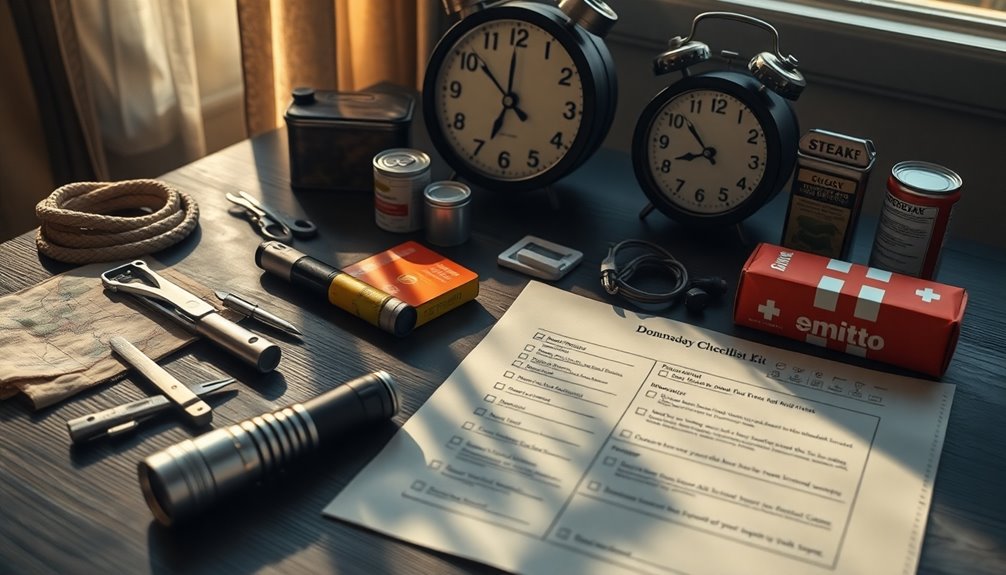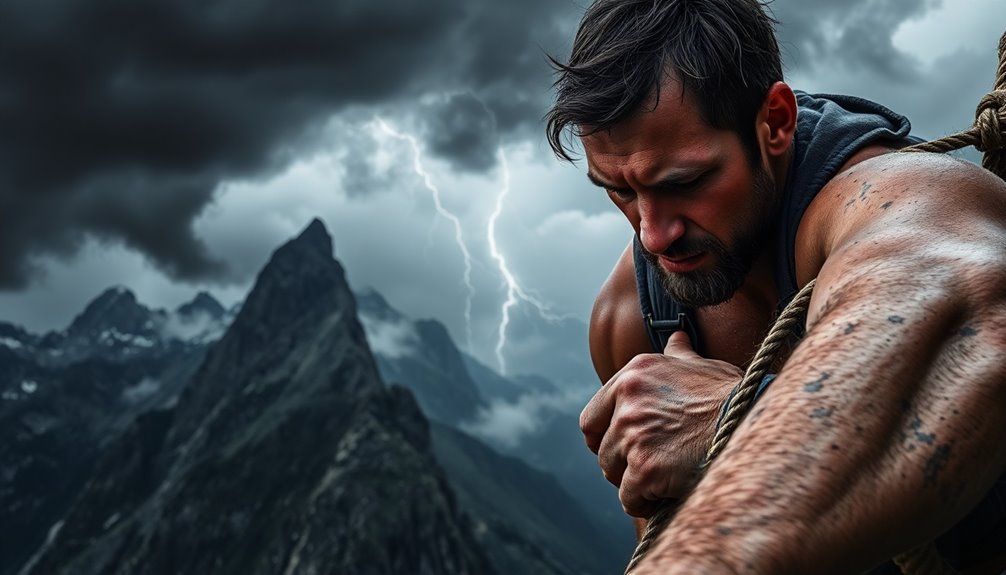Discover the world of preppers: individuals ready for emergencies through food stockpiling, shelter building, and survival skills. Originating in the 1930s due to nuclear threats and Cold War fears, preppers embody self-sufficiency and preparedness for uncertainty. Contrasted with survivalists who focus on extreme skills, preppers emphasize community involvement and safety. Urbanites increasingly embrace prepping for urban emergencies and disruptions, prioritizing self-reliance and sustainable living. Learn about their common preparations like gathering supplies, making emergency plans, and mastering water purification methods. From survivalist terminology to media portrayals, the prepper lifestyle's depth awaits exploration for those curious about this evolving movement.
Key Takeaways
- Preppers are individuals focused on self-sufficiency and readiness for emergencies.
- They prioritize urban preparedness, sustainable living, and stockpiling essential supplies.
- Survivalist lifestyle involves practical preparedness, community involvement, and safety measures.
- Preppers balance normalcy with readiness, preparing for disruptions and crises.
- Understanding survivalist terminology and practices aids in effective prepping strategies.
History of Survivalism
Survivalism originated in the 1930s as a response to government policies, nuclear threats, and apocalyptic writings. During the Cold War, the fear of nuclear war and economic collapse prompted individuals to prepare for potential disasters. Civil defense programs encouraged the construction of shelters and stockpiling of food supplies to mitigate the effects of a nuclear attack. This era saw a surge in survivalist ideas, emphasizing the need for self-sufficiency and readiness in the face of uncertainty.
As tensions heightened and concerns over nuclear war loomed, survivalists in the 1960s shifted their focus towards individual preparations. Inflation, monetary devaluation, and the looming threat of nuclear conflict further fueled the desire for self-reliance and independence. Influential figures like Howard Ruff and Colonel Jeff Cooper played significant roles in promoting survivalist concepts, shaping the evolution of prepping practices over the years.
The history of survivalism reflects a deep-seated human instinct to safeguard against unforeseen catastrophes through preparedness and resilience.
Evolution of Prepping

Prepping has come a long way since its survivalist roots, evolving to encompass a wider spectrum of readiness measures. From stocking up on essentials to developing practical skills, modern prepping emphasizes preparedness for various emergencies.
The shift towards inclusive strategies reflects a broader approach to tackling potential threats, ranging from natural disasters to economic instability.
Prepping Origins
Originating in the historical context of the mid-20th century, the evolution of prepping can be traced back to government policies, societal fears, and influential figures shaping the preparedness mindset. During the Cold War era, civil defense programs in the 1950s emphasized the importance of shelters and food storage, laying the foundation for modern prepping practices.
As the 1960s unfolded, individuals began preparing for potential threats such as inflation, monetary devaluation, and nuclear disasters, further fueling the evolution of prepping into a holistic readiness strategy. Notable figures like Howard Ruff and Colonel Jeff Cooper played pivotal roles in popularizing prepping ideas across different decades, contributing to the spread of self-sufficiency principles.
This historical journey showcases how prepping has transformed over time, integrating diverse skills, knowledge, and resources to equip individuals for emergencies and promote resilience in the face of uncertainty.
Modern Prepper Trends
With a shift towards practical preparedness strategies, modern preppers have adapted their approach to encompass a broader range of potential emergencies. Stockpiling essential supplies has become a cornerstone of modern prepping, ensuring readiness for extended periods.
Alongside this, developing diverse survival skills is emphasized to cope with varying crisis scenarios effectively. Technology plays a pivotal role in modern prepping, with apps, online resources, and advanced gear aiding in preparation and response.
Additionally, community involvement has emerged as a key trend among modern preppers, fostering support networks and shared resources, enhancing overall resilience. This collaborative approach enables preppers to pool knowledge and assets, enhancing their preparedness levels.
Modern prepping reflects a diverse range of concerns, from natural disasters to economic instability, shaping preparedness strategies to be adaptable and all-encompassing. By incorporating these trends, modern preppers are better equipped to face the challenges of an uncertain future.
Prepper Vs. Survivalist Distinctions

When distinguishing between preppers and survivalists, it's important to recognize their contrasting approaches to emergency preparedness and survival skills.
Preppers focus on practical preparedness for various scenarios, emphasizing the importance of stockpiling supplies and organizing group drills to guarantee readiness.
On the other hand, survivalists prioritize extreme survival skills, often investing in wilderness survival training to thrive in challenging environments.
Survivalists tend to adopt a more individualistic mindset, honing their abilities to survive in isolation, while preppers lean towards community involvement, emphasizing safety and well-being for all. Some preppers even draw inspiration from **Mormon preparedness strategies**, which promote self-reliance through stocked food supplies, water storage, and financial prudence for sustained periods of hardship. This community-oriented approach fosters cooperation and shared resources, enhancing the resilience of the group as a whole. In contrast, survivalists often prioritize self-sufficiency over dependency on others, honing skills like hunting, foraging, and building in remote environments.
Despite these differences, both preppers and survivalists share a common goal of being prepared for emergencies and survival situations.
Prepper Lifestyle Choices

What lifestyle choices do preppers prioritize when preparing for emergencies and survival situations?
When it comes to their lifestyle choices, preppers focus on:
- Urban Preparedness: Preppers prioritize being ready for emergencies while living in urban areas, adapting their strategies to suit city living.
- High-Quality Long-Term Storage Food: Stocking up on durable, nutritious food that can last for extended periods is vital for preppers to sustain themselves during crises.
- Post-Election Disruptions: With concerns about potential disruptions following elections, preppers take steps to make sure they're prepared for any political fallout.
- Comfortable Living During Emergencies: While some preppers may choose extreme survivalist methods, lifestyle preppers often aim to maintain a level of comfort and normalcy even in times of crisis.
These lifestyle choices reflect a balance between readiness and everyday living, allowing preppers to be prepared for a range of scenarios without completely altering their way of life.
Common Preparations of Preppers

Preppers commonly gather non-perishable foods, water, and medical supplies for emergencies. They also acquire self-defense tools, communication devices, and off-grid power sources to guarantee security and connectivity during crises.
Additionally, preppers develop emergency plans with evacuation routes, meeting points, and communication protocols for coordination.
Food Stockpiling Techniques
Stockpiling food is a fundamental practice among individuals preparing for emergencies or disasters, ensuring a stable food supply during times of crisis.
When it comes to food stockpiling techniques, preppers commonly follow specific methods to maintain their supplies:
- Preppers often stockpile non-perishable items like canned goods, rice, pasta, and dried fruits for extended storage periods.
- Some choose freeze-dried or dehydrated foods due to their longer shelf life and retained nutrients.
- Vacuum sealing is a vital practice among preppers to prolong the freshness of their food items and prevent spoilage.
- Rotation of food supplies is essential; preppers make a point to consume and replace items before they reach their expiration dates.
Additionally, preppers may opt for bulk food purchases and establish designated emergency food storage areas to ensure they have an adequate supply of food in case of an emergency.
Emergency Shelter Strategies
When preparing for emergencies, ensuring a safe shelter is a critical priority among individuals adopting a survivalist lifestyle. Preppers commonly fortify existing structures such as basements or safe rooms to serve as emergency shelters.
For quick deployment, some preppers opt for portable shelters like tents or survival pods. Underground bunkers are a prevalent choice for long-term shelter during catastrophic events, providing protection from various threats.
In the wilderness, preppers may seek refuge in natural shelters like caves or dense foliage for temporary safety. Additionally, preppers employ the strategy of building hidden or camouflaged shelters to evade detection during emergencies, enhancing their security and privacy.
These emergency shelter strategies are essential components of prepping, ensuring individuals are well-prepared to face unforeseen challenges with a secure place to seek shelter and regroup.
Water Purification Methods
To guarantee your survival during emergencies, understanding water purification methods is essential for preppers in maintaining a safe water supply.
Here are some common water purification methods used by preppers:
- Boiling water: This simple yet effective method kills pathogens, ensuring the water is safe for consumption.
- Chemical treatments: Preppers often use chlorine dioxide tablets or iodine solutions as portable options for purifying water.
- Filtration systems: Portable water filters or straws are popular among preppers for removing contaminants and producing clean drinking water.
- UV sterilization devices: Tools like UV pens or purifiers are efficient in eliminating harmful microorganisms from water, providing a safe drinking option.
Survivalist Terminology Explained

Understanding survivalist terminology is essential for grasping the nuances of the prepper lifestyle and effectively communicating within the community.
Preppers and Survivalists use specific terms like bug out (escaping to a safe location), bug in (staying prepared at home), SHTF (when the situation hits the fan), TEOTWAWKI (the end of the world as we know it), and WROL (without rule of law) to describe different scenarios and preparedness strategies for various emergencies.
These terms reflect the diverse range of situations and responses that survivalists anticipate and prepare for. Familiarity with survivalist terminology helps preppers navigate discussions, resources, and survival strategies effectively.
By understanding these terms, you can better communicate with fellow survivalists, exchange ideas, and collaborate on preparedness plans.
Media Portrayal of Preppers

Media frequently sensationalizes preppers, depicting them as extreme and paranoid individuals preparing for catastrophic events. This portrayal often leads to stereotypes and misconceptions about the prepping community.
TV shows like 'Doomsday Preppers' amplify these stereotypes by focusing on the most extreme examples of prepping practices, further perpetuating the idea that all preppers are preparing for doomsday scenarios. Documentaries and reality TV series tend to highlight the more eccentric aspects of prepping, painting preppers as outliers or fringe groups within society.
Impact on Popular Culture

Survivalism's influence on popular culture is evident through various forms of media and entertainment. TV shows like 'Doomsday Preppers' and movies such as 'Red Dawn' have brought the lifestyle of survivalists and preppers into the mainstream. The rise of survivalist-themed video games like 'Fallout' and 'The Last of Us' further demonstrates the impact of survivalism on popular culture, appealing to audiences intrigued by post-apocalyptic scenarios.
Additionally, survivalist ideologies have permeated popular music, literature, and fashion, shaping the cultural landscape and inspiring new trends. Moreover, survivalist influencers on social media platforms have amassed significant followings, perpetuating survivalist beliefs and practices in popular culture. The portrayal of survivalism in mainstream media has both informed and sensationalized the movement, contributing to its presence in the public eye.
Rise of Lifestyle Preppers

Lifestyle preppers are everyday individuals preparing for emergencies by prioritizing self-sufficiency and stocking up on essential supplies.
They aim to be self-reliant during crises and avoid depending on external resources for survival.
This mindset of readiness and preparedness is becoming increasingly popular among individuals seeking to secure their well-being in uncertain times.
Prepping for Emergencies
With the rise of lifestyle preppers, preparing for emergencies has become a priority for many urban dwellers. As concerns about potential disruptions post-presidential election and FBI warnings of domestic terrorism loom large, urbanites are turning to emergency preparedness.
Here are some key aspects of prepping for emergencies:
- Urban Focus: Lifestyle preppers prioritize urban preparedness, focusing on thriving during emergencies in city settings.
- Supply Chain Disruptions: Major disruptions could lead to empty grocery store shelves rapidly, underlining the need for self-sufficiency.
- Long-Term Food Storage: Lifestyle preppers stock up on high-quality long-term storage food to avoid relying on government assistance during crises.
- Survivalist Food Options: Companies like Prepper All-Naturals offer survival steaks with a 25+ year shelf life, providing nutritious emergency food sources made from all-American beef.
Self-Sufficiency Mindset
Embracing a self-sufficiency mindset, lifestyle preppers prioritize urban preparedness and sustainable living practices to navigate emergencies effectively. They focus on self-reliance, ensuring they can sustain themselves without relying on external help during crisis situations.
Urban preparedness is a key aspect for lifestyle preppers, who seek to maintain a comfortable lifestyle even when faced with disruptions. Stockpiling high-quality long-term storage food is common among lifestyle preppers, enabling them to avoid dependence on government assistance and ensuring they've sustenance during emergencies.
Unlike extreme survivalists, lifestyle preppers don't typically build bunkers or live off-grid but instead integrate preparedness into their daily urban lives. Concerns such as disruptions post-presidential elections, potential riots, and supply chain disruptions leading to empty grocery store shelves drive the preparedness efforts of lifestyle preppers.
Companies like Prepper All-Naturals cater to this group by offering nutritious, high-quality survival food with long shelf lives, supporting their emergency preparedness goals.
Challenges Faced by Preppers

Facing numerous obstacles, preppers encounter various challenges in their efforts to prepare for emergencies and guarantee their survival. These challenges include:
- Sourcing high-quality, long-lasting survival food can be difficult.
- Limited storage space poses a challenge when stocking up on supplies.
- Maintaining a balanced diet with long-term food storage options may be tough.
- Ensuring the rotation of stored supplies to prevent expiration requires careful planning.
Preppers also face the dilemma of balancing the cost of acquiring emergency supplies with other financial obligations. These challenges are magnified in scenarios like socio-economic collapse, where self-sufficiency becomes essential for survival.
Additionally, preppers living in survivalist retreats or off-grid locations encounter unique obstacles due to their remote settings. Overcoming these challenges demands strategic planning, resourcefulness, and a deep commitment to preparedness.
Frequently Asked Questions
What Is the Difference Between a Prepper and a Survivalist?
The difference between a prepper and a survivalist lies in their approach. Preppers prioritize practical preparedness and group involvement, while survivalists focus on extreme survival skills and often maintain a more individualistic stance towards survival scenarios.
What's the Point of Preppers?
In uncertain times, the point of preppers is to be self-reliant by stockpiling resources and honing survival skills. You aim to guarantee access to essentials during emergencies, working towards normalcy and security without external help.
What Does Prepper Stand For?
Prepper stands for a person who actively prepares for emergencies by stockpiling supplies and developing survival skills. They focus on self-reliance, preparedness, and sustainability in the face of potential disasters.
What Are the Characteristics of a Prepper?
Imagine a person who anticipates the unpredictable with unwavering resolve. They embody preparedness, adaptability, and resilience. A prepper is someone who thrives under pressure, prioritizing self-sufficiency and readiness for any crisis scenario.
Conclusion
To sum up, the rise of preppers has been fueled by a growing awareness of potential threats and disasters. One interesting statistic is that 57% of Americans have taken some steps towards emergency preparedness, showing a shift towards a more proactive mindset.
While challenges exist, such as stigma and misconceptions, preppers continue to prioritize self-reliance and readiness for any situation. As the lifestyle gains popularity, it's important to understand the motivations behind prepping and the practical benefits it offers.










